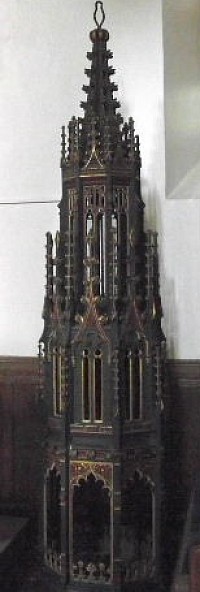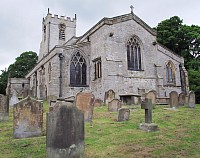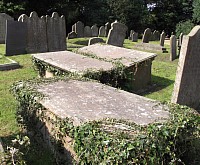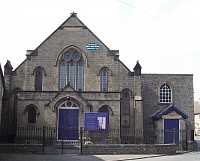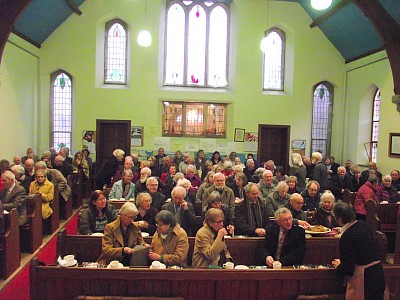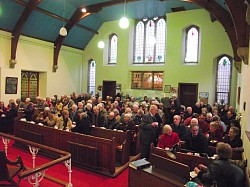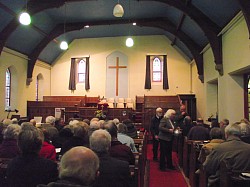Church and Chapel
The Parish Church of St Mary and St Alekelda was given the status of being a collegiate church with the foundation of a college in 1478. This meant that it had a Dean and Canons, the deaneryship ended in 1856, and since then the clergy have been rectors. This stone is above the church door.
This beautiful font cover is a reconstruction made from fragments found in the Old Deanery, now Kingsley House. It was suspended above the font until recently. The church has many other treasures, ancient grave slabs used as lintels above the windows on the north side of the church ; Fragments of medieval glass in the north west window, a tomb slab from Jervaulx Abbey, now in the vestry which is usually locked, but depicts the name of Robert Thornton with thorn leaves and a ton [barrel]. The church formerly had a gallery erected on the north aisle. The subscribers were - Christopher Topham, Thomas Midgeley of Cookridge Hall Leeds, Simon Spence, Margaret Smith spinster, Christopher Scott and John Dixon of the City of London.
Middleham was a Peculiar, which meant that the parish was outside the jurisdiction of the Bishop, and the Dean could hold his own courts. He also found it lucrative to marry couples from outside the parish without banns or a licence.
Robert Boucher Nichols was a Dean of Middleham, he added interesting snippets to the Parish Registers which tell us as much about the Dean as the young clerks in the town. I enter under the head of Burials, as spiritually dead, the names of James Sadler, clerk to Mr John Breare, attorney at law of this place & Christopher Felton, clerk to Mr Luke Yarker, attorney at law of this place, first for irreverent behaviour in Church, secondly at the public reproof when mildly admonished by me not to repeat the same both made use of the most scandalous & insolent words concerning myself, for which I thought it proper to pass a public censure upon them, tho' they were wilfully absent, in the face of the congregation, and I enter the same in this book that the names of the insolent men may go down in posterity as void of all Reverence of God & his ministers. October 29th 1792
The Reverend John Cockcroft was a much loved Anglican clergyman in Middleham, when he died he specified my body to be buried in the churchyard at Middleham a little to the south of the east windows on the chancel where two buttresses have been ordered to support or strengthen the east wall of the chancel as near as may be to the bottom of the said buttresses as not to injur the foundations thereof nor of the walls of the chancel and six poor men to bear me and be paid 2 shillings and 6 pence.....
The interior of the church has changed over time. The glass fronted vestry at the rear of the church is a recent addition. It now covers up the beautiful grave cover that came from Jervaulx Abbey and the Benefaction Board which listed the charities in the parish.
Originally pews were owned by individuals, and notes were made in the Parish Registers " Robert Boucher Nichols granted leave to Robert Burton of the White Swan to repair and enlarge the lowest pew adjoining the north wall" "Robert Boucher Nichols gave permission for John Bywell of Low Gill, parish of Aysgarth, to erect two pews in Middleham Church for the use of his family or tenants as long as they were inhabitants of Middleham"
Another note in the Parish Registers recorded that William Luke Yarker of Middleham had moved the partition which was between the first and second pews adjoining the north aisle at the east end of the church and placed the partition against the east wall. The Reverend John Cockcroft wrote " I do disallow any such alteration and William Luke Yarker doth continue to withhold, after repeated application, the books and papers belonging to Middleham Deanery" John Cockcroft, curate, 14th September 1791
Methodists began meeting in Middleham very early, and by 1793-1794 they were in a position to build their first chapel, this was licensed by the Quarter Sessions on the 29th April 1794. This was in a house at the bottom of Park Lane on land which was given by Elizabeth Stabler. They then moved and built a second chapel on this site, you can see a small part of it on the right hand side of this picture, it is now the Sunday School Room, and this was built in 1811. The present chapel was built in the early 20th century.
The first Class leader was Christopher Simpson who was of Redmire, but apprenticed to Leeds where he heard Mr Wesley preach, and brought the faith back to the dales.
Pigot's Directory of 1834 lists the places of worship as the parish church and a chapel each for the Wesleyan and Primitive Methodists. This stone is on the building which was the Primitive chapel at the top of Kirkgate, and tucked into a corner opposite the White Swan, it is now a house. The two Methodist societies combined and then worshiped at what had been the Wesleyan Chapel.
Middleham became the main chapel in the Wesleyan Methodist Circuit. Christopher Simpson and Leonard Digby were the first members, and Peter Buck came from Danby Mill.
Sadly the congregation at Middleham Methodist Chapel have had to make the decision to close. This is the congregation having a cup of tea after the last service on the 3rd of February 2019 when they were joined by friends from chapels across the dales and heartily sang their favourite hymns.

